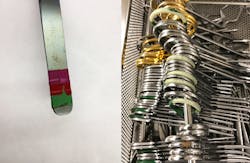Q
“We just had a surveyor come and tell us we cannot use marking tape. Have you heard that marking tape cannot be used any more for identifying instruments?”
A
To my knowledge, I have not heard or read anything stating that you cannot use marking tape or any other means of identifying surgical instruments. My first response to you is to ask the surveyor to produce some type of evidence that states you cannot use marking tape on your instruments.
Now, they might cite you for not using marking tape properly, and that is a different reason.
Over the years, there have been many methods used to mark surgical instruments. Based on my observations, marking tape has been the most popular followed by a “color-coded dipping method.” New and possible better methods are on the horizon.
First, whatever technique is being used to help identify surgical instruments, it should be done according to the Instructions for Use (IFU) of the product you are using. Be sure to consult them before doing any marking.
In general, any method used should not impede the reprocessing of the medical device. In the last few years, medical device reprocessing departments have had more options to mark medical devices to help in traceability or the total instrument sets, and to help ensure that sets are kept together during the reprocessing of those devices.
Let’s look at taping and dipping, and then some of the other options medical device reprocessing department have for use.
Taping and dipping will wear out over time. Staff needs to inspect them each time they touch the instrument and check the integrity of the product according to the IFU. This is part of the inspection of each instrument that should include looking for any worn out tape and replacing it (as well as examining the dipping coating for any cracking/flaking), and sending the instrument out for repair, as necessary.
The color-dipping method is done by the product manufacturer of the surgical instrument or by a third party.
When tape is first applied, it must “cure,” [a chemical process to let the tape set and/or be sterilized], and I do not see that happening all the time. I see staff just apply new tape on the instrument and put it back in the set. This means tape not applied properly—or not removed when it should be—may become a potential source of infections.
Thus, instruments should be cleaned first before tape is applied for the first time, then it can be sterilized and put into service. I’ve witnessed too many times where staff will just remove old tape and apply new tape. This is not correct. When applying instrument tape, the IFU must be followed to get the proper usage and life from the product.
If departments do not want to use taping or dipping, there are other options (e.g., laser/acid etching, color silicone bands, etc.). Departments also must consider the initiative that the United States (U.S.) Food and Drug Administration (FDA) established called the Unique Device Identification (UDI) system to adequately identify medical devices sold in the United States from manufacturers because this process might offer some new techniques able to help that have not been available before. As with any method, each has its advantages and disadvantages, and each department should use their critical thinking skills to determine what method is the best for their needs.
In thinking back to your original comment, this might make sense. Perhaps one or two (or a combination) of different things may have happened at your facility to tip the surveyor off. They might have seen some poorly taped instruments inclining them to comment not to tape your instruments; or maybe they asked if you have a policy on taping and you did not, therefore stating you “… cannot use marking tape.”
Regardless of whichever method a department uses to help identify surgical instruments, a department should have a policy in place with its staff efficiently trained in how to follow it.
I remember these two quotes concerning policy and procedures:
“Walk your talk.” (You may know this as, “Practice what you preach.”)
“If you cannot speak to a policy or procedure, you do not have one to follow.”
In closing, the one method that should not be used is engraving. Why? Because it can harm the surface of the medical device, promote corrosion, and (possibly) decrease the passivation layer of the medical device.
References:
1. Kraayenbrink, M., Baer, S. T., Jenkins, J. G., & Moore-Gillon, V. (1987). Serious hazard of plastic coding tape on surgical instruments. The British Journal of Surgery, 74(8), 696. https://doi.org/10.1002/bjs.1800740815.
2. Ipaktchi, K., Kolnik, A., & Messina, M. (2013). Current surgical instrument labeling techniques may increase the risk of unintentionally retained foreign objects: a hypothesis. Patient Saf Surg, 7(31), 2. https://doi.org/10.1186/1754-9493-7-31.
3. Kostyal, D. A., Verhage, J. M., Beezhold, D. H., & Beck, W. C. (1993). Flash sterilization and instrument tape--an experimental study: Journal of healthcare materiel management, Oct;11(9), 34-5. PMID: 10129224. https://pubmed.ncbi.nlm.nih.gov/10129224/.
4. AAMI (2020). ANSI/AAMI ST79: 2017 Comprehensive guide to steam sterilization and sterility assurance in healthcare facilities (7.4.1 - General considerations for all devices and utensils, 40), Amendment A.2 (2020). Arlington, VA: Association for the Advancement of Medical Instrumentation.
5. Samit, A., Dodson, R. (1983). Instrument-marking Tapes: An Unnecessary Hazard. J Oral Maxillofacial Surg, Oct;41, 687-88. https://doi.org/10.1016/0278-2391(83)90029-0.
About the Author

Stephen M. Kovach
Stephen M Kovach, BS, CFER, started in the medical field in 1975 as a sterilization orderly and has worked in many positions within the Healthcare Industry. He presently is Clinical Educator Emeritus at Healthmark, A Getinge company.

